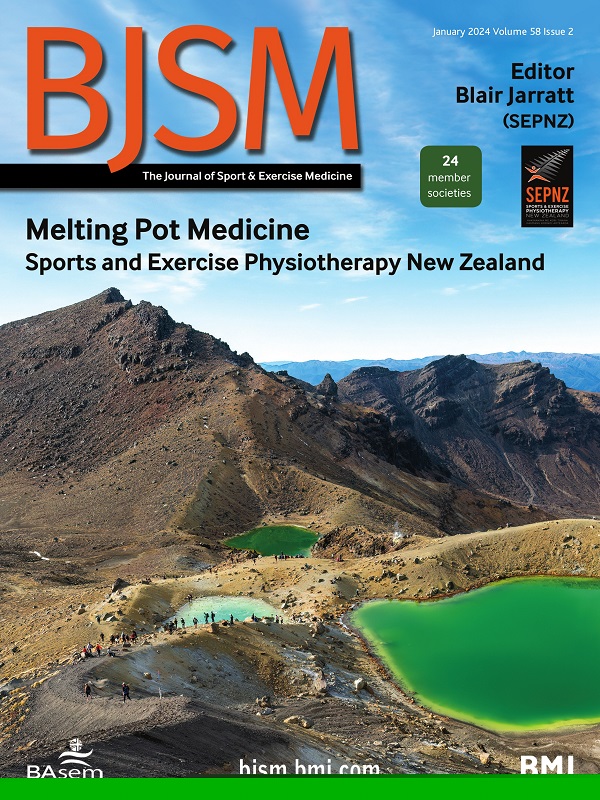Risk for exertional heat illness among US army enlistees: climate indexes, intrinsic factors and their interactions
IF 11.6
1区 医学
Q1 SPORT SCIENCES
引用次数: 0
Abstract
Objectives To characterise intrinsic and extrinsic (climatic) risks for mild and severe exertional heat illness (EHI) among first-year army enlistees. Methods We examined 337 786 soldiers who enlisted between 2012 and 2019. Survival models were used to predict incident EHI from intrinsic factors (demographics, healthcare utilisation, chronic conditions, body mass index (BMI), Army Physical Fitness Test (APFT), upper/lower respiratory tract infections (URTI and LRTI), skin and soft-tissue infections (SSTI), extrinsic factors (geographical region, daily mean Universal Thermal Climate Index (UTCI), wet bulb globe temperature (WBGT)) and interactions. Results There were 1390 cases of mild and 359 cases of severe EHI. Females had a higher risk for mild (adjusted OR (aOR) 1.78; 95% CI 1.57 to 2.02) but a lower risk for severe (aOR 0.61; 95% CI 0.38 to 0.87) EHI. Obesity was associated with severe EHI (aOR: 1.76; 95% CI 1.09 to 2.84) but not mild EHI (aOR: 1.03; 95% CI 0.76 to 1.39). URTI was associated with severe (aOR: 2.44; 95% CI 1.12 to 5.30) and mild (aOR 3.72, 95% CI 2.84 to 4.87) EHI, as were LRTI (severe, aOR: 11.40; 95% CI 6.09 to 21.32; mild, aOR 2.06; 95% CI 1.22 to 3.46), but not SSTI. UTCI outperformed WBGT in predicting EHI. Outside the Southern USA, EHI risk was elevated at lower UTCI. Associations varied over climate conditions and generally did not increase with climatic heat stress. Conclusions Respiratory infections were associated with the highest risk for EHI in soldiers. Risk mitigation strategies may include monitoring prevention and recovery from respiratory infections. Female sex and obesity may have different associated risks over climate conditions. No data are available. Data are derived from official population military records and sources, and were provided to us under strict data use agreement guidelines. Therefore, we cannot reasonably share the data with outside parties. We are willing to share our code to other researchers with access to similar data.美国陆军士兵患运动性中暑病的风险:气候指数、内在因素及其相互作用
目的探讨一年级新兵发生轻度和重度运动性中暑(EHI)的内在和外在(气候)风险。方法对2012年至2019年期间入伍的337786名士兵进行了调查。生存模型用于从内在因素(人口统计学、医疗保健利用、慢性病、体重指数(BMI)、陆军体质测试(APFT)、上/下呼吸道感染(URTI和LRTI)、皮肤和软组织感染(SSTI)、外在因素(地理区域、日平均通用热气候指数(UTCI)、全球湿球温度(WBGT))和相互作用等方面预测EHI事件。结果轻度EHI 1390例,重度EHI 359例。女性患轻度糖尿病的风险较高(调整后OR (aOR) 1.78;95% CI 1.57 - 2.02),但严重的风险较低(aOR 0.61;95% CI 0.38 ~ 0.87) EHI。肥胖与严重EHI相关(aOR: 1.76;95% CI 1.09 ~ 2.84),但没有轻度EHI (aOR: 1.03;95% CI 0.76 ~ 1.39)。URTI与重症患者相关(aOR: 2.44;95% CI 1.12 ~ 5.30)和轻度EHI (aOR 3.72, 95% CI 2.84 ~ 4.87), LRTI(严重,aOR: 11.40;95%可信区间6.09 ~ 21.32;轻度,aOR 2.06;95% CI 1.22 ~ 3.46),但SSTI没有。UTCI在预测EHI方面优于WBGT。在美国南部以外,低UTCI时EHI风险升高。这种关联因气候条件而异,一般不随气候热应激而增加。结论呼吸道感染是士兵EHI的高危因素。风险缓解战略可包括监测呼吸道感染的预防和恢复情况。女性性行为和肥胖在气候条件下可能有不同的相关风险。无数据。数据来源于官方的人口军事记录和来源,并在严格的数据使用协议指导下提供给我们。因此,我们无法合理地与外界共享数据。我们愿意将我们的代码分享给其他能够访问类似数据的研究人员。
本文章由计算机程序翻译,如有差异,请以英文原文为准。
求助全文
约1分钟内获得全文
求助全文
来源期刊
CiteScore
27.10
自引率
4.90%
发文量
217
审稿时长
3-8 weeks
期刊介绍:
The British Journal of Sports Medicine (BJSM) is a dynamic platform that presents groundbreaking research, thought-provoking reviews, and meaningful discussions on sport and exercise medicine. Our focus encompasses various clinically-relevant aspects such as physiotherapy, physical therapy, and rehabilitation. With an aim to foster innovation, education, and knowledge translation, we strive to bridge the gap between research and practical implementation in the field. Our multi-media approach, including web, print, video, and audio resources, along with our active presence on social media, connects a global community of healthcare professionals dedicated to treating active individuals.

 求助内容:
求助内容: 应助结果提醒方式:
应助结果提醒方式:


